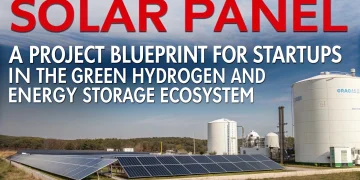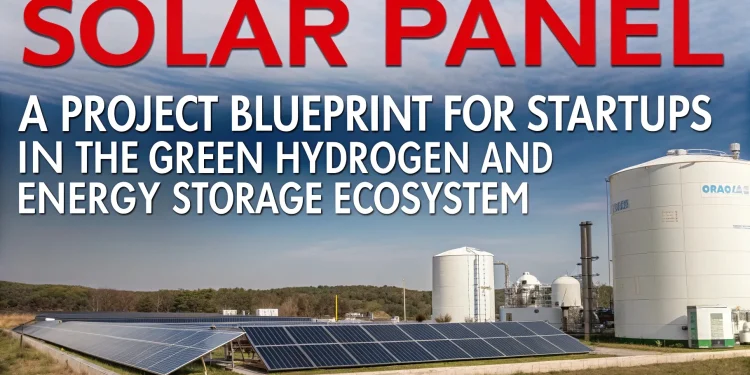For an extended period of time, solar energy has acted as the face of India’s renewable progress. But, with the maturation of clean energy sectors, investors and entrepreneurs are shifting focus to green hydrogen and energy storage systems. These technologies go hand in hand with solar and wind; however, they are essential to fully realizing their potential in achieving a 24/7 carbon-free economy.
Green Hydrogen initiatives are marked by decarbonization pledges, a rise in industrial energy consumption, and an ecosystem powered by advanced technologies. This is transforming it into a clean energy startup hub. In this context, manufacturing is critical. Electrolyzers, Hydrogen purification units, as well as battery cells and pack assemblies, are components of energy infrastructure that require advanced design, domestic manufacturing, and scalability for the next generation/next decade.
This is a guide for industrial entrepreneurs who want to work in these sectors with clear and actionable strategies. It details the sector’s fundamentals, the gaps and the opportunities during the manufacturing process, technology choices, and policy frameworks tailored to B2B businesses, hardware startups, and plant-based models.
India’s Evolving Role in the Green Hydrogen and Energy Storage Ecosystem
India’s energy imports and oil and gas sectors remain a cornerstone of India’s energy security. On the other hand, India’s position in the global energy landscape is changing due to its advanced plans to become a global manufacturing hub for clean energy technologies, green hydrogen systems, and further advances in battery technologies.
Policy directives like the National Green Hydrogen Mission, along with the PLI Scheme for Advanced Chemistry Cell Manufacturing, aim to foster domestic production with an emphasis on local manufacturing in electrolysis systems, battery chemistries, and supporting technologies. The response from the private sector—including corporations and startups—indicates the beginning of industrial localization for clean energy hardware.
Related: Solar PV Power and Solar Products Plant Setup: Empowering Own Business with Green Energy
Sector-Wise Snapshot of the Ecosystem (India, 2025 Baseline)
| Segment | Core Application Area | Key Startup Opportunities | Current Development Stage |
| Green Hydrogen Production | Ammonia, steel, refining, mobility | Electrolyzer stacks, PEM technology, water treatment systems | Early commercial |
| Battery Energy Storage (BESS) | Grid stabilization, EVs, commercial backup | Cell manufacturing, pack assembly, BMS software | Scaling fast |
| Fuel Cell Technology | Long-haul transport, defense, off-grid power | Fuel cell stacks, hydrogen processing modules | Early R&D to pilot stage |
| Hydrogen Infrastructure | Refueling, transport, industrial storage | Compressors, dispensers, tank solutions | Emerging ecosystem |
| Thermal/Flow Storage Systems | Industrial heat, grid storage | Flow battery systems, molten salt storage innovation | Research to pilot |
Understanding the Production of Green Hydrogen: A Technical Overview
The emission of green hydrogen production is in contrast to that of blue and grey hydrogen, as it is steam released during the electrolysis of water and utilizes natural gas and fossil fuels with carbon capture respectively. Because it does not produce carbon dioxide emissions, it is particularly suitable for industries that are in the process of decarbonization.
On a large scale, the working systems are self-contained units and in segments, operational reliability and safety as well as the system integration needs to be optimally managed. Addressing each stage within each segment will improve miniaturization.
Core Steps in Green Hydrogen Production
Water Purification:
Before water undergoes electrolysis, it has to go through a purification step of removing unnecessary components. This has to be done by processes such as deionization and reverse osmosis.
Hydrogen Production Through Electrolysis:
The process of separating hydrogen and oxygen from water using the electric current is called electrolysis. There are broadly three types of electrolyzers:
- Alkaline Electrolyzers (AEL): This older technology is less expensive, but is physically larger and bulkier.
- Proton Exchange Membrane (PEM): More modern and compact, this type of electrolyzer works efficiently with solar power and other seasonal energy sources.
- Solid Oxide Electrolyzers (SOEC): These high-temperature systems are much more efficient when part of a heat-integrated setup.
Gas Separation and Drying:
The produced hydrogen and oxygen gases contain water vapor and other impurities that need to be filtered out to obtain the required gas purity, so dryers and gas filters are used for this purpose. These systems can remove moisture and achieve dry hydrogen and oxygen gas purity levels above 99.99%.
Compression and Storage:
Hydrogen can be stored as gas or liquid in specially designed high-pressure tanks (350 to 700 bar). Its compressed form is stored cryogenically or in high-pressure cylinders, which are standard for transportation.
Dispatch or Use On-Site:
While onsite hydrogen is used for producing ammonia and steel, it can also be shipped to industrial customers through pipelines and road tankers.
Modular Green Hydrogen Units For Industrial Campuses:
Startups entering this field can focus on designing modular green hydrogen plants for industrial campuses, control systems, purification systems, or even electrolyzer stack manufacturing.
Battery Manufacturing for Energy Storage: A Blueprint Based On Processes
India cannot achieve the goals of monitoring grid power—especially from renewable sources—while electrifying transportation without local battery production. Currently, the majority of batteries in use for electric vehicles, solar backup systems, and industrial UPS systems are imported.
With policy backing and incentives for infrastructure, the government has made it easy for startups to step into cell manufacturing, battery module design, or even battery recycling.
Core Stages in Manufacturing Lithium-Ion Batteries
Preparing Raw Materials:
Conductive additives and binders are combined with active materials such as lithium iron phosphate (LFP) or nickel manganese cobalt (NMC).
Electronically active metal foils are anode and cathode. They undergo a drying process after being coated with slurries and subjected to stirring.
Formation of Electrodes While Assembling the Batteries:
The coated foils are cut and then wound with separators to produce cell cores. These are then kalendared.
Depending on the format (cylindrical, prismatic, pouch), these cores are assembled into polymeric or aluminum enclosures.
Electrolyte Filling and Battery Sealing:
Under strict conditions, lithium salts in organic solvents are filled into the batteries serving as electrolytes.
The use of heat or ultrasonic welding provides airtight seals to the cells.
Formation Cycling and Testing:
The batteries undergo a controlled charge and discharge cycle to stabilize chemistry during testing.
Quality testing is performed on energy density, thermal behavior, and cycle life.
Module and Pack Integration:
Cells are grouped into modules with BMS (Battery Management System) units at the cell level.
Packs are tailored for EVs, solar storage, or industrial applications as per their voltage and power requirements.
Such tailored products also enable new specialized startups for materials synthesis, optimization of cell design for weight and volume, safety software for batteries, or targeted packaging design for telecom towers, mini-grids, and other use-case specific stationary power supplies.
Related: Emerging Trends in Solar Energy Ventures and Their Profit Potential
Where Hardware Startups Can Contribute: Hydrogen and Battery Infrastructure
Green energy systems cannot function in silos. The area around hydrogen production and battery storage is still largely unexplored and offers many startup opportunities in hardware systems design or component-level system integration.
| Infrastructure Area | Startup Opportunity |
| Hydrogen Storage Tanks | Tank composite materials for high-pressure waterproof seal design |
| Battery Enclosures & Modules | Custom housing for industrial or EV battery packs |
| Compressors and Blowers | HYDROGEN compression units with low noise and low-power operational modes |
| BMS and Monitoring Software | Analytics applications for real-time data on battery or H2 unit performance |
| Skid-mounted Hydrogen Plants | On-site modular units for hydrogen generation |
Startups focused on manufacturing systems and skids with IoT monitoring devices can target industrial parks, utility operators, and logistics providers with differentiated offerings.
Policy Initiatives Enabling Clean Manufacturing Startups
India’s clean energy initiatives are driven by strategic policy initiatives. The National Green Hydrogen Mission establishes the direction and the Production Linked Incentive (PLI) scheme on battery cell manufacturing provides generous incentives for startups venturing into manufacturing.
In addition, Special Economic Zones are being set up to encourage and support industrial innovation alongside Foreign Direct Investment (FDI) inflows and public-private research and development consortia.
Important initiatives include:
- PLI for Advanced Chemistry Cell (₹18,100 crore)
- Viability Gap Funding for pilot projects of green hydrogen
- Import electrolyzer short term customs duty exemptions
- Initiatives for Hydrogen Valleys in several important states
For more information check out this video
Role of NIIR Project Consultancy Services (NPCS)
For entrepreneurs seeking to enter the green hydrogen and battery manufacturing sectors, reliable data and expert project planning are essential.
Niir Project Consultancy Services (NPCS) offers end-to-end guidance with its market-validated feasibility reports and industrial blueprints.
NPCS provides:
- Market Survey cum Detailed Techno-Economic Feasibility Reports tailored to niche manufacturing ventures.
- Detailed guidance on raw materials, production processes, plant layout, and regulatory norms.
- Strategic consulting to assess the feasibility and scalability of setting up new industrial plants.
Conclusion: Time to Manufacture the Future
Green hydrogen and energy storage are no longer futuristic aspirations—they are present-day necessities for India’s energy transformation. For startups, this is not merely about jumping on a trend but about building the very tools and hardware that will drive energy sovereignty, industrial competitiveness, and carbon neutrality.
The success of solar energy in India was largely import-driven. But the success of green hydrogen and energy storage depends on domestic innovation and manufacturing. The opportunity is clear. The roadmap is being laid. What’s needed now is a bold generation of entrepreneurs ready to manufacture the future.


















